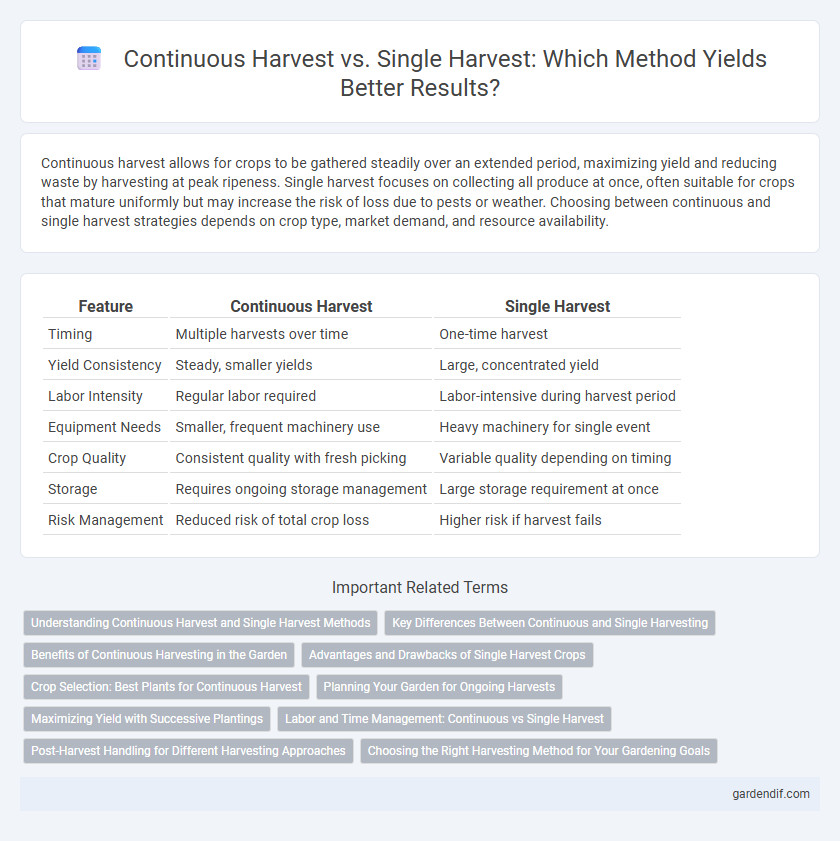
Continuous harvest vs single harvest Illustration
Continuous harvest allows for crops to be gathered steadily over an extended period, maximizing yield and reducing waste by harvesting at peak ripeness. Single harvest focuses on collecting all produce at once, often suitable for crops that mature uniformly but may increase the risk of loss due to pests or weather. Choosing between continuous and single harvest strategies depends on crop type, market demand, and resource availability.
Table of Comparison
| Feature | Continuous Harvest | Single Harvest |
|---|---|---|
| Timing | Multiple harvests over time | One-time harvest |
| Yield Consistency | Steady, smaller yields | Large, concentrated yield |
| Labor Intensity | Regular labor required | Labor-intensive during harvest period |
| Equipment Needs | Smaller, frequent machinery use | Heavy machinery for single event |
| Crop Quality | Consistent quality with fresh picking | Variable quality depending on timing |
| Storage | Requires ongoing storage management | Large storage requirement at once |
| Risk Management | Reduced risk of total crop loss | Higher risk if harvest fails |
Understanding Continuous Harvest and Single Harvest Methods
Continuous harvest involves regularly collecting crops over an extended period, allowing for ongoing yield and fresher produce. Single harvest methods concentrate all crop gathering at once, maximizing efficiency but limiting harvest duration. Understanding these approaches helps optimize resource use and meet specific market demands.
Key Differences Between Continuous and Single Harvesting
Continuous harvest involves regularly collecting crops over an extended period, ensuring a steady supply and reducing storage needs, whereas single harvest gathers all produce at once, typically leading to larger initial yields but increased risk of spoilage. Continuous harvesting optimizes labor distribution and market availability by staggering harvest times, while single harvest can maximize efficiency in harvesting operations but requires adequate post-harvest handling. Crop type, climate conditions, and market demands are crucial factors influencing the choice between continuous and single harvest methods.
Benefits of Continuous Harvesting in the Garden
Continuous harvesting extends the growing season by allowing crops to be picked repeatedly, ensuring a steady supply of fresh produce. This method improves plant health by promoting ongoing growth and reducing waste from overripe fruits or vegetables. Gardeners benefit from increased yield efficiency and optimized space utilization, making continuous harvesting ideal for maximizing garden productivity.
Advantages and Drawbacks of Single Harvest Crops
Single harvest crops enable efficient resource allocation by concentrating labor and machinery use into a defined timeframe, reducing operational complexity and costs. However, single harvest systems may increase the risk of total crop loss due to pest outbreaks or adverse weather events occurring at critical harvesting periods. This approach often limits flexibility in market timing and may result in lower overall yield compared to continuous harvest methods that spread production across multiple cycles.
Crop Selection: Best Plants for Continuous Harvest
Selecting crops such as lettuce, spinach, and bush beans optimizes continuous harvest due to their rapid growth cycles and ability to produce multiple yields. Herbs like basil and cilantro also thrive under continuous harvest systems, providing fresh foliage throughout the growing season. Choosing these plants enhances productivity by allowing growers to pick mature leaves or pods regularly without replanting.
Planning Your Garden for Ongoing Harvests
Planning your garden for ongoing harvests involves selecting crops with staggered maturity dates to ensure continuous yield throughout the season. Implementing succession planting techniques maximizes space and extends productivity by replacing harvested plants with new seedlings. Choosing varieties known for multiple harvests per season, such as bush beans or leafy greens, supports a steady supply of fresh produce.
Maximizing Yield with Successive Plantings
Continuous harvest strategies, involving successive plantings at staggered intervals, significantly maximize yield by ensuring a steady supply of mature crops throughout the season. Unlike single harvest methods, which produce one large yield at a single point in time, continuous harvest optimizes land use and reduces periods of idle soil. This approach is particularly effective for high-demand vegetables like lettuce, spinach, and radishes, where market freshness and consistent availability enhance profitability.
Labor and Time Management: Continuous vs Single Harvest
Continuous harvest reduces labor spikes by distributing work evenly over time, enhancing workforce efficiency and minimizing overtime costs. Single harvest demands intense labor within a short timeframe, often requiring temporary workers and increased scheduling complexity. Effective time management in continuous harvest supports consistent productivity, while single harvest requires precise coordination to handle labor surges and equipment usage.
Post-Harvest Handling for Different Harvesting Approaches
Continuous harvest allows for immediate post-harvest handling focused on sorting and packaging smaller, frequent yields, reducing the risk of spoilage and maintaining optimal freshness. Single harvest typically requires large-scale handling operations concentrated within a narrow time frame, necessitating rapid processing and storage to preserve crop quality. Efficient temperature control and moisture management are critical in both methods to extend shelf life and minimize post-harvest losses.
Choosing the Right Harvesting Method for Your Gardening Goals
Continuous harvest allows gardeners to reap fresh produce consistently over an extended period, maximizing yield and ensuring a steady supply of crops like lettuce, herbs, and beans. Single harvest focuses on growing crops that mature simultaneously, such as pumpkins or corn, providing a large, concentrated yield ideal for preserving or bulk storing. Selecting between continuous and single harvest should align with your gardening goals, space availability, and desired timing for crop consumption.
Continuous harvest vs single harvest Infographic

 gardendif.com
gardendif.com